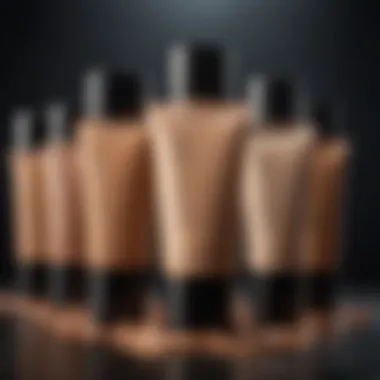Waterproof Foundation Tips for Oily Skin


Intro
Individuals with oily skin often encounter distinct challenges when it comes to makeup application and longevity. This guide aims to provide comprehensive insights into waterproof foundations tailored specifically for oily skin. Understanding the nature of oily skin is vital to selecting the right makeup products. Oily skin is characterized by excess sebum production, which can lead to a shiny appearance and difficulties in maintaining makeup throughout the day.
In this guide, you will find critical information on the unique attributes of effective waterproof foundations, key application techniques, and essential maintenance tips. This content is designed to empower individuals to make informed choices that will enhance their makeup experience.
Tips and How-Tos
Selecting the right foundation is only the first step. Here are strategies to consider to optimize your makeup routine.
Skincare Routines for Different Skin Types
A successful makeup application for oily skin starts with a solid skincare routine. Use a gentle cleanser to remove excess oil without stripping the skin. After cleansing, apply a lightweight, oil-free moisturizer. Here’s a simple routine to follow:
- Cleanser: Use a gel-based or foaming cleanser.
- Toner: Use a toner with salicylic acid to help control oil and prevent breakouts.
- Moisturizer: Choose an oil-free, mattifying moisturizer, such as Clinique Dramatically Different Oil-Free Gel.
- Primer: Always apply a mattifying primer before foundation to create a smooth base and control shine.
- Recommended brands: Neutrogena Oil-Free Acne Wash, La Roche-Posay Purifying Foaming Gel.
Application Techniques
When applying waterproof foundation, precision matters. Follow these steps:
- Use a damp beauty sponge: This method helps in stippling the foundation into the skin seamlessly.
- Apply in layers: Start with a thin layer and build coverage as needed for a natural look.
- Set with powder: To lock in the foundation, use a translucent setting powder. Brands like Laura Mercier are known for their excellent options.
Maintenance Tips
Foundation can wear off throughout the day due to oil production. Here are some tips to maintain your look:
- Carry oil-absorbing sheets: These can quickly absorb excess shine without disturbing your makeup.
- Use a setting spray: A good setting spray will seal your makeup in place for extended wear.
"Choosing the right waterproof foundation can significantly alleviate the struggles associated with oily skin, providing a lasting finish and a fresh appearance."
Sustainable Practices
As beauty products continue to evolve, so does the conversation around sustainable practices. While discussing waterproof foundations, it is important to consider the impact of product choices on the environment. Selecting brands that are committed to sustainability can lead to more responsible consumer habits.
Eco-Friendly Foundation Brands
Look for brands that prioritize eco-friendly practices, such as cruelty-free testing, recyclable packaging, and organic ingredients. Brands like bareMinerals and Fenty Beauty have gained recognition in this arena.
Celebrating Diversity in Beauty
Makeup is a universal language that transcends cultural boundaries. The beauty industry is increasingly recognizing the need for inclusive products that cater to all skin tones and types. This inclusivity enhances the beauty experience for every individual.
Inclusive Beauty Brands
Several brands are known for their commitment to diversity. Fenty Beauty, for example, offers a wide range of shades and formulations tailor-made for various skin types.
Cultural Influences on Fashion
Cultural backgrounds can significantly shape beauty standards and preferences. As beauty continues to evolve, embracing these diverse influences enriches the makeup landscape, making it more accessible to all.
Understanding Oily Skin
Oily skin presents unique challenges and requires tailored solutions, especially when it comes to choosing the right foundation. Understanding the specific needs of oily skin is crucial for selecting a waterproof foundation that not only adheres well but also controls excess oil throughout the day. Recognizing what causes oily skin, its characteristics, and common concerns can promote informed choices in product selection.
What Causes Oily Skin
Oily skin generally stems from overactive sebaceous glands, which produce excess sebum. This may be influenced by genetics, hormonal changes, and even environmental factors.
- Hormones: Fluctuations during puberty, menstrual cycles, or pregnancy can lead to increased oil production.
- Diet: A diet high in sugar and fats can exacerbate oiliness.
- Climate: Humidity and heat can trigger glands to produce more oil.
Understanding the root causes of oily skin is important when considering how different foundations will perform.
Characteristics of Oily Skin
Oily skin typically displays distinct characteristics that set it apart.
- Shiny Appearance: The most recognizable trait is a shiny complexion, particularly in the T-zone (forehead, nose, and chin).
- Enlarged Pores: Overproduction of oil can lead to visible pores, making skin look uneven.
- Prone to Acne: Oily skin often struggles with acne and breakouts due to clogged pores from excess oil and dead skin cells.
These characteristics guide which formulations will work best for individuals with oily skin and emphasize the need for specific products designed to counteract these issues.
Common Concerns for Oily Skin


Those with oily skin often express several concerns related to makeup products and their performance. Some common concerns include:
- Makeup Longevity: Many worry that makeup will slide off their face throughout the day.
- Oil Control: Maintaining a matte finish is difficult, leading to the constant need for touch-ups.
- Skin Sensitivity: Some may experience reactions to products, resulting in irritation or breakouts.
"Finding the right waterproof foundation can significantly reduce concerns like frequent touch-ups and unwanted shine, offering long-lasting solutions for oily skin."
Addressing these concerns provides clarity on what features to look for in a waterproof foundation. Proper understanding of oily skin is key to effectively narrowing down suitable products.
The Importance of Waterproof Foundation
When it comes to makeup choices for oily skin, selecting the right foundation is crucial. A waterproof foundation is essential for individuals with oily skin due to its ability to endure challenging conditions. The unique properties of waterproof formulations maintain the appearance of the skin throughout the day, even under environmental stressors like humidity and sweat. This article emphasizes the vital role that waterproof foundation plays in enhancing not just the look, but also the durability of makeup for those dealing with oily skin.
Defining Waterproof Foundation
Waterproof foundation refers to makeup formulations specifically designed to resist water, sweat, and oil. These products typically contain ingredients that create a barrier against moisture while providing an even coverage. This means that they can stay intact longer than regular foundations, making them suitable for everyday wear and special occasions alike. Such foundations often come in various finishes and consistencies, allowing individuals with oily skin diverse options to match their preferences and skin tones.
Benefits for Oily Skin
Longevity
The longevity of waterproof foundation is a key attribute. For those with oily skin, makeup can fade or break down quickly. Waterproof products are designed to last through the highest levels of sweat and humidity. This means fewer touch-ups during the day. The long-lasting formula helps in maintaining a fresh look from morning till night, which is a significant advantage. It is popular not only for its staying power but also because it can withstand challenges, allowing individuals with oily skin to feel secure in their makeup choice.
Oil Control
Oil control is another critical benefit when discussing waterproof foundations. Oily skin types often produce excess sebum, leading to a shiny appearance. Waterproof foundations typically contain oil-absorbing agents, which work to reduce shine and keep the skin looking matte. This feature is especially beneficial as it helps prevent the need for frequent blotting, providing a more polished look throughout the day.
Minimal Smudging
Minimal smudging is an important factor linked to waterproof foundations. Oily skin can lead to makeup migrating or smudging, especially in humid conditions. Waterproof formulas are designed to minimize this issue. This ensures that the application remains intact and looks fresh. The unique formulation provides a barrier that helps keep the foundation in place, offering peace of mind to those concerned about their makeup's performance.
"Choosing the right waterproof foundation can revolutionize the makeup routine of anyone with oily skin. It's about confidence in your appearance, regardless of conditions."
Key Ingredients to Look For
When it comes to selecting a waterproof foundation tailored for oily skin, the ingredients are crucial. They determine how well a product adheres, controls oil, and maintains a fresh appearance throughout the day. Understanding what to look for can lead to better choices, enhancing both the wearability and effectiveness of the foundation. Below are key categories of ingredients that should be at the forefront of your decision-making process.
Oil Absorbing Agents
One of the primary concerns for those with oily skin is excess sebum production. This is where oil-absorbing agents come into play. These ingredients help to minimize shine and keep the skin looking matte for extended periods. Common oil-absorbers include kaolin clay, silica, and rice powder.
- Kaolin Clay: This natural clay not only absorbs oil but also helps to draw out impurities from the skin.
- Silica: Often found in high-end formulations, silica can absorb moisture while allowing the skin to breathe.
- Rice Powder: Known for its lightweight texture, rice powder helps in providing a smoother finish by controlling oil without feeling heavy.
Incorporating products with these ingredients can greatly improve the experience of wearing foundation on oily skin.
Waterproof Formulations
Waterproof foundations are specifically formulated to withstand humidity, sweat, and your natural oils. These formulations usually include film-forming agents like acrylates and silicone-based compounds. Such ingredients not only resist water but also create a barrier against oil and moisture.
- Acrylates: These chemicals provide long-lasting hold and are flexible, preventing the makeup from cracking.
- Silicones: Ingredients such as dimethicone add a smooth, silky texture to foundations and help in creating that water-resistant quality.
- Polymeric Formulas: These complex ingredients can adapt to the skin's movement while providing coverage.
Choosing products with a robust waterproof formulation can ensure that your makeup will last under various conditions without sacrificing coverage.
Skin Conditioning Additives
While controlling oil is vital, maintaining skin health should not be overlooked. Look for skin conditioning additives that nourish and hydrate the skin without adding extra shine. Ingredients like hyaluronic acid, glycerin, and vitamin E can offer benefits while still being oil-free.
- Hyaluronic Acid: This powerful humectant provides hydration, ensuring the skin remains plump without feeling greasy.
- Glycerin: Known for its moisturizing properties, glycerin helps in maintaining the skin's moisture barrier while adding to the foundation's overall texture.
- Vitamin E: As an antioxidant, vitamin E helps protect the skin from free radicals and can soothe irritation as well.
Despite the focus on waterproof performance, these additives can improve the feeling and appearance of the skin, ultimately leading to a more pleasant wear.
"The right combination of ingredients can make all the difference. Look for products that balance oil control with skin nourishment for the best results."
By focusing on these key ingredients, finding a waterproof foundation that meets the specific needs of oily skin becomes a more targeted and informed process.
Top Waterproof Foundations for Oily Skin
Choosing the right waterproof foundation is crucial for individuals with oily skin. The nature of oily skin can lead to rapid makeup breakdown, making it essential to select products specifically designed to withstand excess sebum and environmental factors. The following sections explore various categories of waterproof foundations that cater to this need, ensuring longevity and maintaining a fresh appearance throughout the day.
High-End Options
High-end waterproof foundations are formulated with advanced technology and premium ingredients. They not only provide coverage but also enhance the skin's texture. Brands like Estée Lauder Double Wear Stay-in-Place Makeup and NARS All Day Luminous Weightless Foundation are notable choices. Their compositions are particularly beneficial for oily skin, offering a matte finish without feeling heavy. These products often incorporate oil-absorbing elements that help to control shine, making them a worthy investment for anyone looking to achieve a polished look.
One distinct advantage of these foundations is the shade range available. High-end brands typically provide a diverse selection, allowing you to find a perfect match to your skin tone. Moreover, the quality of wear is usually superior, with ingredients meant to resist humidity and sweat, ensuring that your makeup stays intact.
Affordable Alternatives


Oily skin does not have to mean breaking the bank. There are several affordable waterproof foundations that provide excellent performance without a hefty price tag. Maybelline Fit Me Matte + Poreless Foundation and L'Oreal Infallible Pro-Matte Foundation are superb options for budget-conscious consumers.
These foundations boast formulations that are lightweight yet buildable, allowing for customizable coverage. They control oil effectively, minimizing the need for touch-ups during the day. In addition, they provide a pleasing finish that rivals more expensive counterparts. If you are looking for an economical choice that meets the demands of oily skin, these alternatives should be high on your list of considerations.
Drugstore Brands Worth Considering
Many drugstore brands have caught up to high-end formulations, making them viable contenders in the waterproof foundation sphere. Examples include Revlon Colorstay Makeup for oily/combo skin and CoverGirl Clean Matte BB Cream. These products deliver reliable performance without sacrificing quality.
Drugstore foundations often cater to a wide audience, addressing various skin tones and types. They are also accessible, making them easy to find at local retailers. Importantly, these foundations maintain the requisite oily skin benefits, ensuring that users experience a minimized shine while enjoying long-lasting coverage.
In summary, selecting a waterproof foundation for oily skin is pivotal. Through the exploration of high-end options, affordable alternatives, and reliable drugstore brands, consumers can find a product tailored to their needs. Each category brings its unique benefits, ensuring that everyone can achieve a flawless look while managing oiliness effectively.
Choosing the Right Shade
Choosing the right shade of waterproof foundation is crucial for achieving a natural look. The foundation should seamlessly blend with your skin tone. A mismatched foundation can lead to an uneven appearance, drawing attention to imperfections rather than masking them. For individuals with oily skin, the shade selection also impacts how the product performs throughout the day. A foundation too light or dark can exacerbate oiliness, making it appear more noticeable.
Moreover, selecting the correct shade helps in enhancing your overall makeup look. When your foundation matches your natural skin tone, it creates a unified canvas. This enables other products, like blush or bronzer, to sit better and maintain their color integrity throughout the day. Hence, understanding how to identify your undertone and conducting tests in natural light are essential steps in this process.
How to Identify Your Undertone
Identifying your undertone is the first step in selecting the right shade of foundation. Undertones are classified into three main categories: cool, warm, and neutral. Knowing your undertone helps in narrowing down the shade range that will look best on you.
- Cool Undertones: If you have pink, red, or bluish hues to your skin, you likely have cool undertones. Individuals with cool undertones usually find that shades with a rosy or ivory base complement their skin.
- Warm Undertones: Those with yellow, golden, or peachy tones fall into this category. Shades that have a yellow or golden base tend to blend well with warm undertones.
- Neutral Undertones: If you find that both warm and cool shades suit you, you likely have a neutral undertone. Neutral shades blend more easily, providing flexibility in color selection.
To help identify your undertone, consider using the wrist test. When you look at your veins, if they appear blue, you are likely cool-toned. If they look greenish, you may have warm undertones. If it is hard to tell, then reflect on neutral.
Testing in Natural Light
Testing your foundation shade in natural light is essential for making the right choice. Store lighting can alter the perception of color, leading to misleading results. Natural light provides a true representation of how the foundation will appear throughout the day.
To test your foundation:
- Apply a small amount of product on your jawline, blending it in. This area ensures the shade is visible alongside your neck.
- Step outside or stand in a well-lit area to observe the foundation under natural light.
- Look for a seamless blend. The foundation should disappear into your skin tone without creating a stark contrast.
- If possible, wear the foundation for a couple of hours to see how it interacts with your skin.
A well-matched shade of foundation is not only about covering flaws but also enhances your natural beauty.
By following these two key methods, the chance of ending up with an inappropriate shade decreases significantly. The right shade not only helps individuals with oily skin to achieve a polished look but also boosts confidence, making it an integral aspect of the overall makeup routine.
Application Techniques for Best Results
Applying waterproof foundation effectively is essential for those with oily skin. The right techniques can significantly enhance the appearance and longevity of the makeup. It sets the stage for a flawless finish while allowing the foundation to resist the effects of excess oil and humidity. Without proper application, even the best foundation can fail to perform, leading to unwanted shine and the need for frequent touch-ups. Therefore, understanding how to prepare the skin, choosing the correct tools, and mastering layering methods can make a difference in your overall makeup experience.
Prepping Your Skin
Before applying waterproof foundation, it is crucial to prep the skin. This means cleansing, toning, and moisturizing properly. Cleansing removes impurities and excess oil, ensuring a clean canvas. Toning helps to tighten pores and balance skin pH. Moisturizing is necessary, even for oily skin types, as it hydrates without adding extra grease. Oil-free moisturizers or those with mattifying properties can be especially useful.
Additionally, applying a mattifying primer can enhance the effectiveness of a waterproof foundation. Primers help to fill in fine lines and create a smoother surface. They also improve the adhesion of foundation, which is essential for all-day wear.
Using the Right Tools
The tools used in makeup application play a significant role in achieving desired results. Two popular options are brushes and sponges, each with its unique benefits and considerations.
Brush vs. Sponge
Using a brush for applying waterproof foundation allows for more precision. Brushes, particularly those with synthetic bristles, help distribute the product evenly without absorbing excess makeup. This characteristic of brushes makes them a beneficial choice for achieving a buildable coverage. They are particularly effective in areas that need extra attention, such as around the nose or under the eyes. However, brushes can sometimes leave streaks if not used properly.
Sponge applicators, conversely, provide a more blended finish. They are great for those looking for a lighter application as they tend to absorb more product, which can be an advantage or disadvantage based on personal preference. The dampened sponge technique allows for a seamless and natural look, reducing the appearance of any cakeiness that may arise from denser formulas.
Fingers as a Tool
Using fingers as a tool for foundation application can seem unconventional, but it is a practical option. The warmth from the skin helps to melt the product, allowing for a more natural application. This method is especially effective for those who prefer a lightweight finish.
Fingers can provide excellent control over the amount of product being applied, enabling quick touch-ups throughout the day. However, it's essential to ensure clean hands to prevent transferring oils and bacteria to the face. While fingers may lack the precision of a brush, they excel at blending, particularly along the jawline and hairline, where a seamless transition is necessary.
Layering Techniques
Layering foundation can help achieve the desired coverage without making the skin appear overpoweringly made up. The method involves starting with a thin layer of waterproof foundation and gradually adding more as needed. It is a technique that works well for oily skin, as it prevents the product from becoming too heavy or prone to breaking down during wear.
When layering, allow each layer to set before adding the next one. This helps in achieving optimum adherence on the skin. Complete your look with a setting spray or powder to lock everything in place, ensuring it withstands the pressures of daily life, from humidity to sweat.
Maintaining Waterproof Foundation Throughout the Day
Maintaining waterproof foundation throughout the day is crucial, especially for those with oily skin. The adaptability and durability of a foundation can significantly influence its overall effectiveness. Oily skin tends to disrupt makeup, leading to slipping or fading of foundation. Therefore, adopting methods to ensure longevity becomes essential. This not only enhances your appearance but also provides comfort and confidence in your makeup routine.
Setting Spray vs. Powder


When it comes to finishing touches, the choice between setting spray and powder is often debated. Setting sprays offer a final layer of moisture, helping to bond the foundation with your skin for a seamless look. They can also provide a more natural finish, reducing the chance of a cakey appearance, which is vital for oily skin. Sprays are typically lightweight and can help refresh your makeup throughout the day.
On the other hand, setting powders work by absorbing excess oil and providing a matte finish. They can be particularly beneficial in controlling shine, a common concern for oily skin types. However, excessive powder can sometimes lead to a flat appearance or emphasize texture. Balancing the two methods can often yield the best results, depending on the climate and your skin’s oil production.
Blotting Techniques
Blotting techniques serve as a handy tool for managing oil throughout the day, especially for oily skin. Rather than piling on layers of powder, consider using blotting papers. These thin sheets can effectively soak up excess oil without disturbing your foundation. Gently press a sheet onto oily areas, such as the forehead and nose, to absorb shine.
Alternatively, one can use a clean tissue or cloth to blot. The goal is to absorb oil rather than rub it away, which could disrupt the makeup underneath.
To recap, both setting sprays and powders have their own advantages, benefiting oily skin in unique ways. Using blotting techniques can help maintain a polished look without compromising the integrity of your foundation. Adjusting your approach based on personal preference and daily conditions will ensure your makeup remains intact, reflecting the effort put into your application.
"A good makeup routine is not just about applying products; it involves maintaining that look as the day progresses."
Removing Waterproof Foundation
Removing a waterproof foundation can be as crucial as the application process itself. Given the unique properties of these products, which are designed to withstand moisture, humidity, and oil, it is essential to adopt effective techniques for safe removal. Failing to do so can lead to clogged pores, breakouts, or even skin irritation. This section focuses on the strategies for effectively removing waterproof foundations, highlighting specific elements that can enhance this process and ensure skin health.
Cleansing Oils and Balms
Cleansing oils and balms serve as excellent solutions when removing waterproof foundation. They work by dissolving makeup products, making it easier to wash them away without scrubbing harshly.
The primary advantage of using cleansing oils is their ability to penetrate the skin thoroughly. They lift the foundation without stripping the natural oils from the skin. This is especially beneficial for oily skin types that may already produce excess oil. Look for products that contain nourishing ingredients like jojoba oil or grapeseed oil, as these not only help in cleansing but also add hydration.
When using a cleansing balm, always follow the instructions. Scoop a small amount and rub it between your palms to warm it up before applying. Gently massage onto dry skin, allowing it to dissolve the makeup. Rinse with warm water, and follow it with your regular cleanser to ensure all residue is removed. This two-step method enhances cleansing efficiency and prepares the skin for further treatment.
"Using the right type of cleanser is essential. Cleansing oils and balms can transform your makeup removal routine, ensuring skin health while effectively removing waterproof products."
Gentle Cleansing Methods
Gentle cleansing methods are integral to ensuring that foundation is removed without causing harm to the skin. After the initial removal with oils or balms, it is advisable to use a mild facial cleanser. Products labeled as fragrance-free and non-comedogenic are often best for oily skin.
Incorporating a soft washcloth or cotton pads can be beneficial. Dampen your cloth or pad with warm water and gently wipe away any residual product. Avoid using excessive force, which can irritate the skin. Rinse your face again with lukewarm water to ensure no remnants are left.
For those who prefer a more natural approach, consider using micellar water. Its gentle formula effectively lifts makeup without harsh rubbing. Just soak a cotton pad with micellar water and dab it across the skin. It reduces the risk of irritation and supports skin balance, especially for sensitive skin.
Potential Challenges with Waterproof Formulas
Waterproof foundations are often touted as the ideal solution for individuals with oily skin. However, it is crucial to recognize that these products are not without challenges. Understanding these potential difficulties can help users prepare better and make more informed decisions. In this section, we will explore the learning curve associated with application and the risk of skin sensitivity issues.
Learning Curve for Application
Application of waterproof foundation may require a different approach compared to traditional formulas. It is essential to grasp the techniques that work best with these products. Many users might find that their usual methods do not yield satisfactory results.
To start, waterproof foundations often have thicker textures. This can make blending more challenging. If applied improperly, the foundation can look cakey or uneven. Using the right tools, such as damp sponges or specific foundation brushes, can aid in achieving a smoother finish. Additionally, layering must be approached with caution. Applying too much product can result in a heavy look, while too little may not provide adequate coverage.
It may take time to master the application techniques for effective results. Therefore, practice is essential. Doing trial runs before significant occasions allows users to refine their skills.
Skin Sensitivity Issues
Another challenge to consider is the potential for skin sensitivity. Waterproof foundations contain ingredients designed to resist water and oil. While these ingredients can be beneficial for longevity, they may also cause irritation for some individuals.
Formulas that include alcohol or heavy fillers can exacerbate sensitivity, particularly for those prone to breakouts or irritation. It is vital to examine ingredients carefully and perform patch tests.
If irritation occurs, it may be necessary to consult a dermatologist or opt for alternative products, such as hypoallergenic or non-comedogenic options. Users should not compromise skin health for durability.
Remember, finding the right waterproof foundation is a balance between achieving the desired look and maintaining skin health.
In summary, understanding these potential challenges is essential for anyone considering a waterproof foundation for oily skin. Through awareness of application techniques and potential skin reactions, users can enhance their overall experience.
Epilogue
The importance of the conclusion lies in reinforcing the knowledge acquired throughout the article. This section serves as a summary of the vital elements discussed, linking them with practical considerations for readers. A well-rounded conclusion ensures that the key takeaways are crystal clear, aiding those with oily skin in their pursuit of effective waterproof foundations. Additionally, this part highlights the practical benefits of selecting the right foundation, which can make a substantial difference in daily makeup routines. It is crucial to remind readers that they must assess each product thoughtfully, paying attention to their unique skin characteristics and preferences.
Recap of Key Points
In this article, we delved into several critical aspects:
- Understanding Oily Skin: Recognizing the causes and characteristics of oily skin is necessary for effective makeup choices.
- Waterproof Foundation: Defined as makeup that withstands sweat and humidity, this type is especially beneficial for those prone to excess oil.
- Key Ingredients: Identifying oil-absorbing agents and skin-enhancing additives ensures informed decisions when selecting products.
- Product Recommendations: We highlighted high-end, affordable, and drugstore options to cater to various budgets and preferences.
- Application Techniques: Proper techniques can maximize the effectiveness and longevity of waterproof foundation.
- Maintenance and Removal: Insightful strategies help keep makeup looking fresh all day and ensure a gentle removal process.
- Challenges: Awareness of potential difficulties related to waterproof formulas promotes better preparation and selection.
This recap helps to solidify the knowledge gained and illustrates the thoroughness of this guide, creating a pathway toward choosing suitable foundations.
Final Thoughts on Choosing the Right Foundation
Selecting the right foundation requires careful consideration. Women, regardless of age, should prioritize understanding their skin type. Oily skin brings unique challenges, and the market offers a multitude of solutions.
When choosing a waterproof foundation, keep these points in mind:
- Skin Compatibility: Ensure the foundation matches your skin's needs and sensitivities.
- Testing Products: Always test shades in natural light and believe in the power of trial.
- Long-Term Commitment: Investing in a quality foundation is worthwhile; not only does it enhance appearance, but it also supports skincare.
By emphasizing an informed approach, we encourage readers to take the necessary steps to find their ideal foundation. A tailored product can greatly enhance confidence and overall well-being while managing oil effectively throughout the day.







